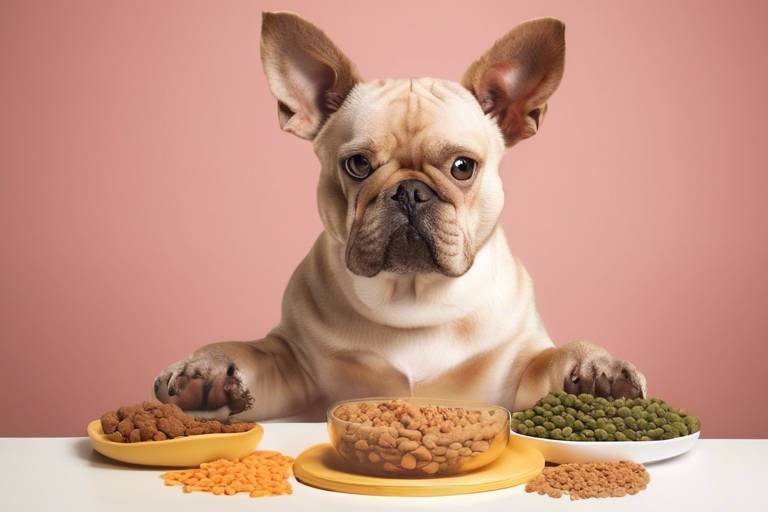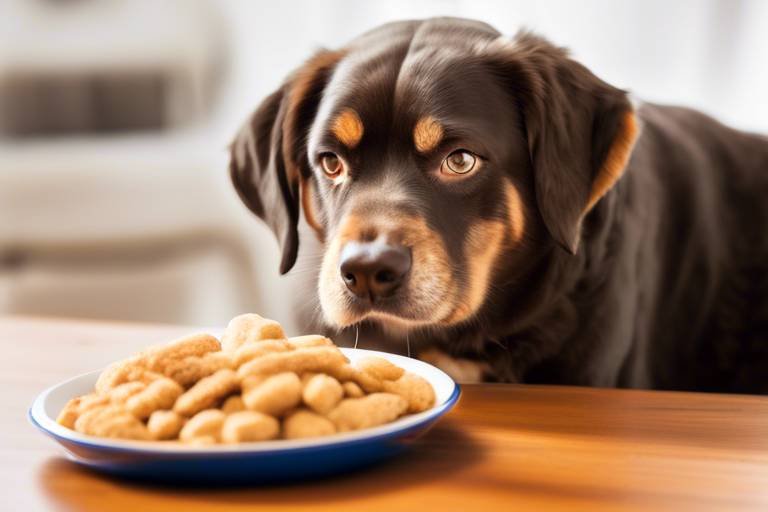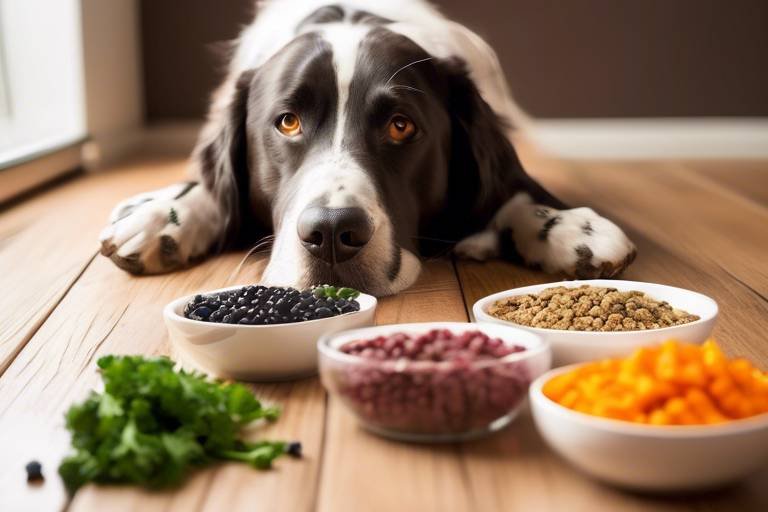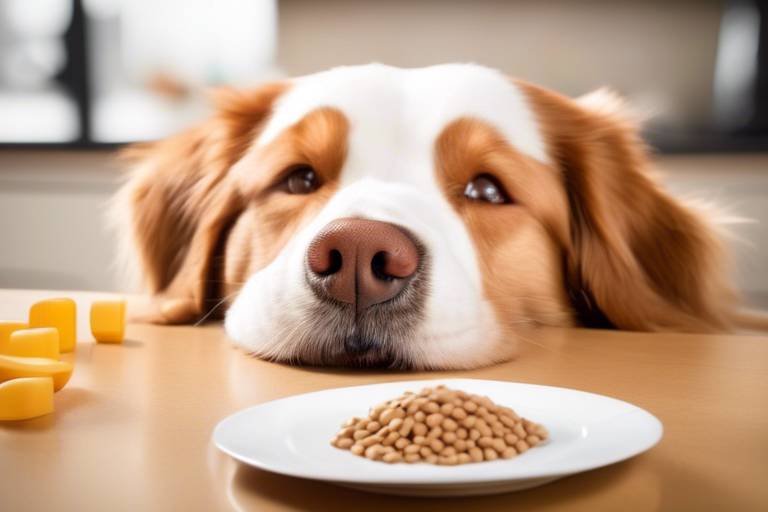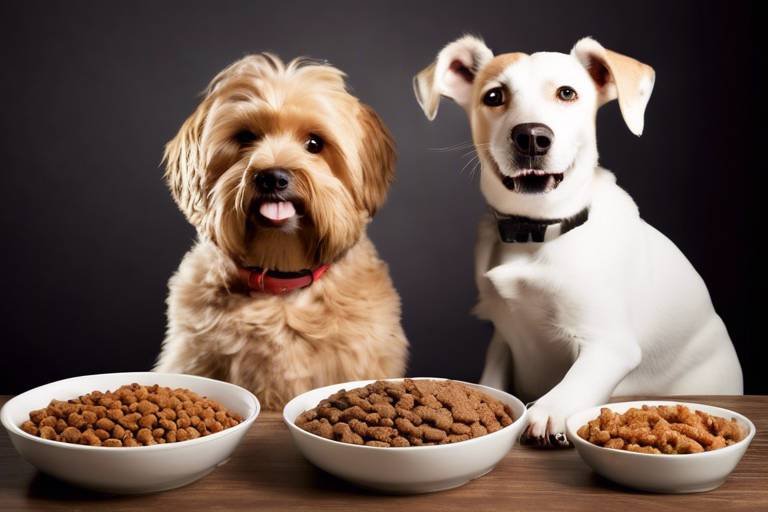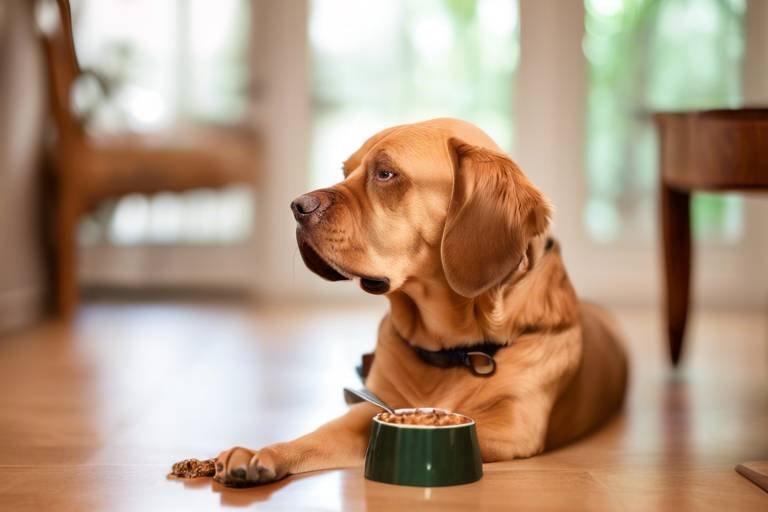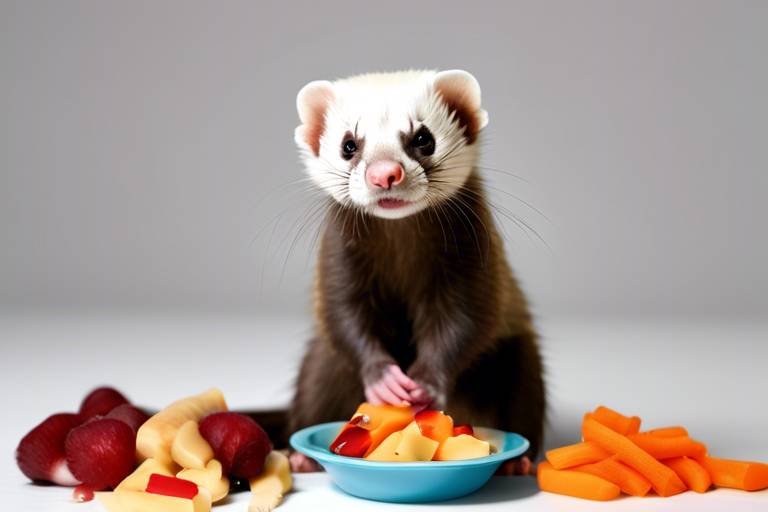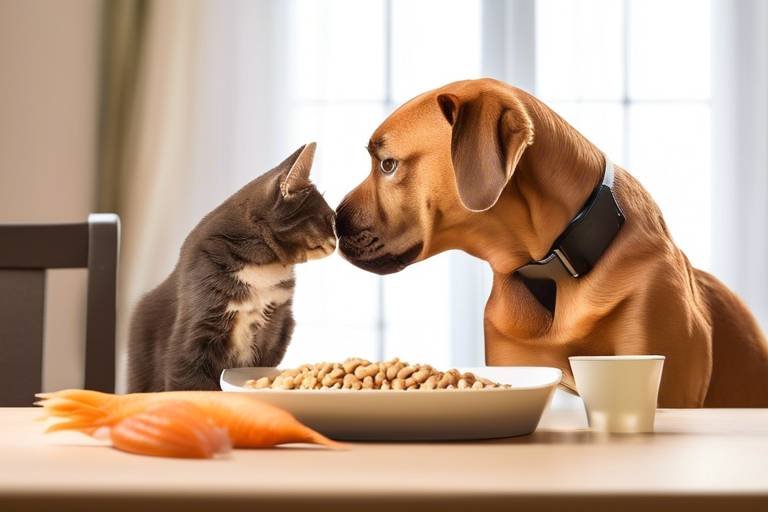How to Monitor Your Pet’s Food Intake
When it comes to our furry friends, ensuring they have a balanced diet is crucial for their health and happiness. Monitoring your pet's food intake may seem like a daunting task, but it can be as simple as keeping a few key strategies in mind. By being proactive and attentive, you can help your pet maintain a healthy weight, avoid potential health issues, and even enhance their overall quality of life. Imagine this: just like we keep track of our own eating habits to stay fit and energetic, our pets deserve the same level of care and attention!
So, how do we start? First, we need to understand that each pet is unique, with specific dietary requirements based on factors such as age, size, breed, and health conditions. For instance, a growing puppy has different nutritional needs compared to a senior dog. Similarly, a playful kitten will require more energy-dense food than an adult cat. By recognizing these differences, you can tailor their diet to suit their individual needs.
Once you have a clear understanding of your pet's nutritional requirements, the next step is choosing the right food. This involves not just picking a brand off the shelf but diving deep into the ingredients and nutritional information. High-quality pet food should contain wholesome ingredients that are beneficial to your pet's health. It's important to read food labels carefully; understanding what's in your pet's food can make all the difference. For instance, look for real meat as the first ingredient, and avoid foods that list fillers or artificial preservatives.
Speaking of labels, let’s talk about how to decode them. Pet food labels can be overwhelming, but they’re essential for making informed choices. Look for the guaranteed analysis, which provides information on protein, fat, fiber, and moisture content. This will help you determine if the food meets your pet's dietary needs. Additionally, be aware of common ingredients to avoid, such as by-products or unnamed meat sources, which can lead to health issues down the line.
Understanding feeding guidelines is also a vital component of monitoring your pet's food intake. Most manufacturers provide recommendations based on your pet's weight and age. However, these are just guidelines and should be adjusted according to your pet's specific needs. For instance, if your pet is less active, you may need to reduce their portion sizes to prevent obesity.
Portion control is another effective technique to ensure your pet is getting the right amount of food. Measuring their meals can help prevent overfeeding or underfeeding. Use a standard measuring cup and stick to the recommended serving sizes. This simple act can make a significant impact on your pet's health. You might even consider investing in a kitchen scale for more precise measurements.
In today's digital age, technology can be a great ally in monitoring your pet's food intake. There are numerous apps and devices designed to assist pet owners in tracking their pets' eating habits. These tools can help you log meals, track consumption, and even set reminders for feeding times, making it easier to stay on top of your pet’s diet.
For example, pet feeding apps like "Pet First" or "Pawtrack" allow you to input your pet's dietary needs and monitor their meals throughout the day. They can send you notifications when it's time to feed your pet, ensuring that you never miss a meal. On the other hand, smart feeding devices take it a step further by allowing you to control portion sizes remotely. These innovative feeders can dispense food at scheduled times, helping you maintain a consistent feeding routine.
In conclusion, monitoring your pet's food intake is not just about counting calories; it's about ensuring they live a long, healthy, and happy life. By understanding their nutritional needs, choosing the right food, controlling portions, and utilizing technology, you can create a balanced diet that suits your pet perfectly. Remember, a healthy pet is a happy pet, and your efforts will surely pay off in the long run!
- How often should I feed my pet? – Most pets do well with two meals a day, but this can vary based on age and health conditions.
- What should I do if my pet is overweight? – Consult your veterinarian for a tailored diet plan and consider increasing their activity levels.
- Can I mix different types of pet food? – It's generally safe, but make sure the foods are compatible and consult your vet if unsure.
- How can I tell if my pet is getting enough nutrition? – Regular vet check-ups, monitoring their weight, and observing their energy levels can provide insights.

Understanding Your Pet’s Nutritional Needs
When it comes to keeping our furry friends healthy, understanding their nutritional needs is crucial. Just like us, pets require a balanced diet tailored to their specific requirements. Factors such as age, size, and health conditions play a significant role in determining what your pet should eat. For instance, a growing puppy has different needs than a senior dog, and a large breed has different requirements than a small breed. By grasping these nuances, you can provide your pet with the best possible nutrition.
Let’s break it down a bit more. Puppies and kittens need a diet rich in protein and fat to support their rapid growth and energy levels. On the other hand, adult pets typically require a balanced diet that maintains their health without causing weight gain. Senior pets, however, often need fewer calories but more fiber to aid digestion and address age-related health issues.
Here’s a quick overview of how different factors influence your pet’s dietary needs:
- Age: Puppies and kittens require more calories and nutrients compared to adults. Senior pets may need diets lower in calories but higher in fiber.
- Size: Larger breeds have different caloric needs than smaller breeds. They also might be more prone to certain health issues, necessitating specific dietary considerations.
- Health Conditions: Pets with health issues such as diabetes, allergies, or kidney disease may require special diets prescribed by veterinarians.
Moreover, it’s essential to consider your pet's lifestyle. An active dog, for example, will need more energy than a couch potato. If your pet is primarily indoors, they may not require as many calories, so adjusting their food intake accordingly is vital to prevent obesity. It’s all about finding that sweet spot where your pet feels energetic and healthy without tipping the scales.
To further assist in understanding your pet’s needs, it’s a good idea to consult with your veterinarian. They can provide personalized recommendations based on your pet’s specific situation, including any necessary dietary adjustments. Remember, your pet's health is an investment, and the right nutrition is a foundational piece of that puzzle.
In summary, understanding your pet's nutritional needs is not just about feeding them; it's about ensuring they thrive. By considering their age, size, health conditions, and lifestyle, you can make informed decisions that lead to a happier, healthier pet.

Choosing the Right Food
When it comes to your furry friend's diet, selecting the right food is **crucial** for their health and happiness. You wouldn't feed your child junk food every day, right? The same principle applies to your pets. Choosing high-quality pet food that meets their nutritional needs is not just about filling their bowl; it’s about providing them with the **vital nutrients** they require to thrive. Start by considering your pet's specific needs based on their age, size, breed, and any existing health conditions. For instance, a growing puppy has different requirements compared to a senior dog. It's all about customizing their diet to ensure they’re getting the right balance of proteins, fats, carbohydrates, vitamins, and minerals.
When selecting pet food, the **ingredients** matter immensely. Look for foods that list meat as the first ingredient, as this indicates a higher protein content, which is essential for muscle development and overall health. Avoid fillers like corn and soy, which offer little nutritional value. While browsing through the pet food aisle, pay close attention to the labels. You might feel like you need a degree in nutrition to decode them, but don’t worry! Understanding a few key terms can make a significant difference. For example, terms like "complete and balanced" mean the food meets the nutritional standards set by the AAFCO (Association of American Feed Control Officials). This is a good sign!
Moreover, it’s important to consider the portion sizes recommended on the packaging. These guidelines are based on general averages and may not suit every pet. For example, an active dog may require more food than a couch potato. Adjusting these portion sizes based on your pet’s lifestyle can help prevent obesity or malnourishment. If you’re unsure, consulting with your veterinarian can provide personalized guidance tailored to your pet’s specific needs.
Here’s a quick table to illustrate some common pet food types and their typical nutritional focuses:
| Pet Food Type | Main Nutritional Focus |
|---|---|
| Dry Kibble | High in carbohydrates and fiber; good for dental health |
| Canned Food | Higher moisture content; often more palatable |
| Raw Diet | High in protein; mimics natural diet but requires careful handling |
| Grain-Free Options | Suitable for pets with grain allergies; focus on alternative carbohydrates |
In conclusion, choosing the right food for your pet is an essential part of being a responsible pet owner. It’s not just about what’s on the shelf; it’s about understanding what’s best for your pet’s unique needs. So, take the time to research, read labels, and consult with professionals. Your pet will thank you with wagging tails and happy purrs!
Q: How do I know if my pet is getting the right nutrition?
A: Regular vet check-ups can help assess your pet's health and nutritional needs. Additionally, observe their energy levels, coat condition, and overall demeanor.
Q: Can I mix different types of pet food?
A: Yes, but it’s essential to do so gradually and ensure that the combined diets meet all nutritional requirements.
Q: What should I do if my pet has food allergies?
A: Consult your veterinarian for advice on hypoallergenic diets or specific food recommendations tailored to your pet’s allergies.
Reading Food Labels
When it comes to choosing the right food for your furry friend, understanding how to read pet food labels is essential. It’s like deciphering a secret code that unlocks the mysteries of your pet’s dietary needs. Just like we scrutinize nutritional labels on our food, it’s crucial to do the same for our pets. The first thing to look for is the ingredient list, which is typically arranged in descending order by weight. This means that the first ingredient is the most significant part of the food, and ideally, you want to see high-quality protein sources like chicken, beef, or fish at the top. If you see vague terms like "meat by-products," it might be a red flag.
Next, pay attention to the nutritional information provided on the label. This section gives you a snapshot of the essential nutrients included in the food, such as protein, fat, fiber, and moisture content. For instance, a food labeled as "complete and balanced" should meet the standards set by the Association of American Feed Control Officials (AAFCO). This is your assurance that the food provides all the necessary nutrients your pet needs to thrive.
Another critical aspect is the guaranteed analysis, which outlines the minimum and maximum percentages of key nutrients. Here’s a quick breakdown of what to look for:
| Nutrient | Minimum Percentage | Maximum Percentage |
|---|---|---|
| Crude Protein | Minimum 20% | — |
| Crude Fat | Minimum 8% | — |
| Crude Fiber | — | Maximum 5% |
| Moisture | — | Maximum 10% |
Understanding these numbers can help you gauge whether the food matches your pet’s specific needs. For example, if your pet is active and energetic, they might require a diet higher in protein and fat. On the other hand, a less active pet might benefit from lower fat content to prevent weight gain.
Don’t forget to check for any additional claims on the packaging, such as "grain-free" or "natural." These terms can be misleading, so it’s essential to do your research and ensure that such claims are backed by reputable sources. Always remember, what works for one pet might not work for another, so it’s crucial to tailor their diet according to their unique health needs.
In summary, reading pet food labels is not just about picking the prettiest bag off the shelf. It’s about making informed decisions that contribute to your pet's long-term health and happiness. By understanding the ingredients, nutritional information, and guaranteed analysis, you can ensure that you’re providing your beloved companion with the best possible diet.
- How can I tell if a pet food is high quality? Look for named protein sources at the top of the ingredient list and check for AAFCO approval.
- What does "complete and balanced" mean? It means the food meets the nutritional standards set by AAFCO for your pet's specific life stage.
- Are grain-free diets better for pets? Not necessarily; it depends on your pet's individual health needs. Consult your vet for personalized advice.
- How often should I read food labels? Always read the label when purchasing a new food, and periodically check the labels of your current food for any changes.
Common Ingredients to Avoid
When it comes to choosing the right food for your beloved pet, being aware of common harmful ingredients is crucial. Many pet foods contain fillers and additives that can be detrimental to your pet's health. For instance, by-products are often included in pet food, which can consist of leftover parts from animal processing that are not fit for human consumption. These can lack the essential nutrients your pet needs for a balanced diet.
Additionally, certain grains like corn and wheat are frequently used as cheap fillers. While not inherently bad, they can lead to allergies and digestive issues in some pets, particularly dogs. It's important to consider your pet's specific health needs and any known allergies when selecting their food.
Another ingredient to watch out for is artificial preservatives. Ingredients such as BHA, BHT, and ethoxyquin are often used to prolong shelf life but can pose health risks, including cancer. Instead, look for foods that use natural preservatives like vitamin E and vitamin C.
Moreover, sugar and salt can sneak into pet foods under various names and can lead to obesity and other health problems. Always check the ingredient list for these hidden dangers. Here's a quick rundown of ingredients to avoid:
- By-products - Low-quality protein sources.
- Artificial preservatives - Chemicals that can be harmful.
- Excessive fillers - Ingredients like corn and wheat.
- Sugar and salt - Can lead to obesity and health issues.
Ultimately, reading the ingredient list is your best defense against harmful additives. If you see something you don’t recognize or can’t pronounce, it’s worth doing a little research. Your pet deserves the best, and knowing what to avoid is a big step toward ensuring a healthy and happy life for them.
Q: What are by-products in pet food?
A: By-products are leftover parts from animal processing that are not typically used for human consumption. They can include organs, bones, and other parts that may not provide the nutritional value your pet needs.
Q: Is corn a bad ingredient for pets?
A: Corn itself is not inherently bad, but some pets may have allergies to it. It is often used as a cheap filler and may not provide the best nutritional value compared to other protein sources.
Q: How can I tell if a pet food is of high quality?
A: Look for foods that list high-quality protein sources as the first ingredient, avoid those with artificial preservatives, and ensure that the ingredient list is clear and understandable.
Q: What should I do if I suspect my pet has an allergy?
A: If you suspect your pet has an allergy, consult your veterinarian for advice. They may recommend an elimination diet or specific tests to determine the cause of the allergy.
Understanding Feeding Guidelines
Feeding guidelines are essential for ensuring that our furry friends receive the right amount of nutrition they need to thrive. These guidelines, typically provided by pet food manufacturers, can serve as a valuable starting point for determining how much to feed your pet. However, it’s important to remember that these are just general recommendations and may not apply perfectly to every individual pet. Factors such as age, activity level, size, and health conditions all play a significant role in determining your pet's specific dietary needs.
When looking at feeding guidelines, you'll often find a range of suggested amounts based on your pet's weight. For example, a small dog may require only a cup or two of food per day, while larger breeds could need several cups. Here’s a simple breakdown:
| Pet Weight | Daily Food Amount (Cups) |
|---|---|
| 5-10 lbs | 1/2 - 1 cup |
| 11-20 lbs | 1 - 1 1/2 cups |
| 21-50 lbs | 1 1/2 - 3 cups |
| 51-100 lbs | 3 - 5 cups |
While these figures can give you a ballpark estimate, it’s crucial to adjust the feeding amounts based on your pet's unique lifestyle. For instance, if your dog is particularly active, they may require more food than what is suggested. Conversely, if they spend most of their day lounging around, they might need less. Always keep an eye on your pet's body condition; if they are gaining or losing weight too quickly, it may be time to reassess their food intake.
Another important aspect of feeding guidelines is understanding how to measure your pet’s food accurately. Using a standard measuring cup is the best way to ensure that you’re providing the right amount. Avoid using household cups or bowls, as they can vary significantly in size, leading to inconsistencies in portion sizes. It’s also beneficial to divide the daily food amount into multiple smaller meals, especially for pets prone to digestive issues.
Lastly, consider consulting with your veterinarian to fine-tune your pet’s diet based on their health needs. They can provide personalized advice that takes into account any specific conditions your pet might have, such as allergies or weight management issues. Remember, a well-fed pet is a happy pet, and understanding feeding guidelines is a significant step toward achieving that!
- How do I know if I'm feeding my pet the right amount? Monitor their weight and body condition, and consult with your veterinarian for personalized advice.
- Can I free-feed my pet? It depends on the pet; some do well with free feeding, while others may overeat. Always observe their eating habits.
- What if my pet doesn’t finish their food? If your pet consistently leaves food behind, consider reducing the portion size or consulting your vet.
Portion Control Techniques
When it comes to keeping your pet healthy, portion control is absolutely crucial. Just like us humans, pets can easily fall into the trap of overeating, which can lead to a myriad of health issues such as obesity, diabetes, and joint problems. So, how do you ensure that you're serving the right amount of food? Let's dive into some effective portion control techniques that can help you maintain your furry friend's ideal weight.
First off, it’s essential to know your pet’s ideal weight and caloric needs. Factors like age, size, and activity level all play a significant role in determining how much food your pet should consume daily. You can consult with your veterinarian to get a specific recommendation tailored to your pet's needs. Once you have that number, you can start implementing portion control techniques.
One of the simplest methods is to use a measuring cup or a scale. It might sound basic, but many pet owners underestimate how much they’re actually feeding their pets. By measuring out the recommended portion sizes, you eliminate guesswork and ensure your pet gets just what they need. For example, if your veterinarian suggests that your dog should eat 2 cups of food a day, split that into two meals of 1 cup each. This not only helps with portion control but also keeps your pet feeling satisfied throughout the day.
Another technique involves using slow feeders. These specialized bowls are designed to slow down your pet’s eating, which can prevent them from gobbling up their food too quickly. Rapid eating can lead to digestive issues and even bloating. With a slow feeder, you can control the portion size while also promoting healthier eating habits. Plus, watching your pet figure out how to get the food out can be quite entertaining!
For those who prefer a more high-tech approach, consider investing in a smart feeder. These devices allow you to program specific portion sizes and feeding times, ensuring your pet gets their meals on schedule. Some smart feeders even connect to apps on your smartphone, giving you the ability to monitor your pet's eating habits from anywhere. This is especially useful for busy pet owners who may not always be home for feeding times.
It's also beneficial to establish a feeding schedule. Instead of leaving food out all day, try feeding your pet at the same times each day. This routine helps regulate their hunger cues and can prevent them from begging or scavenging for food outside of meal times. Establishing a schedule also allows you to monitor how much your pet is eating over time, making it easier to spot any changes in appetite that could indicate health issues.
Lastly, always remember to adjust portions based on your pet's activity level. If your pet has been particularly active, they may require a bit more food. Conversely, if they’ve been more sedentary, you might need to cut back a little. Keeping a close eye on their weight and body condition is key, as it will help you make informed decisions about their diet.
In summary, portion control is a vital aspect of maintaining your pet's health. By measuring food, utilizing slow feeders, considering smart feeding devices, establishing a feeding schedule, and adjusting portions based on activity levels, you can help ensure your furry friend stays happy and healthy. Remember, a well-fed pet is a happy pet!
- How do I know how much to feed my pet? Consult your veterinarian for specific caloric needs based on your pet's age, size, and activity level.
- What are slow feeders and how do they work? Slow feeders are bowls designed with obstacles that slow down your pet's eating, promoting healthier eating habits.
- Can I use a smart feeder for multiple pets? Yes, many smart feeders can be programmed for multiple pets, allowing you to manage their feeding schedules effectively.
- How often should I feed my pet? It's generally recommended to feed adult pets twice a day, but consult your veterinarian for personalized advice.

Using Technology for Tracking
In today's fast-paced world, technology has become an invaluable ally in ensuring our furry friends get the nutrition they need. Gone are the days of guessing how much food to pour into the bowl or relying solely on our memory to track feeding times. With a plethora of tools and apps at our fingertips, monitoring your pet's food intake has never been easier or more efficient. Imagine having a personal assistant dedicated to your pet's dietary needs—sounds like a dream, right? Well, it’s now a reality!
One of the most exciting advancements in pet care technology is the rise of pet feeding apps. These applications can help you log meals, track consumption, and even set reminders for feeding times. They often come equipped with features that allow you to input your pet’s specific dietary needs, making it easier to ensure they are getting the right amount of food. For example, you can set daily goals based on your pet's weight and health requirements, and the app will notify you if you're veering off track. This level of monitoring not only helps in maintaining a balanced diet but also contributes to your pet's overall health and longevity.
Moreover, these apps often provide insightful analytics, allowing you to visualize your pet's eating habits over time. You can see trends and make adjustments as necessary, ensuring your pet is always on the right dietary path. It’s like having a nutritionist in your pocket! Some popular pet feeding apps include:
- Pawtrack - Ideal for tracking your pet's meals and health metrics.
- Pet First Aid - Offers a variety of features, including meal logging and health tips.
- MyPet Reminders - Perfect for setting feeding schedules and reminders.
In addition to apps, smart feeding devices have revolutionized the way we manage our pets' diets. These innovative gadgets allow for precise portion control and remote monitoring of your pet's feeding habits. Imagine being able to feed your pet a specific amount of food while you’re at work or even on vacation! Smart feeders connect to your home Wi-Fi, enabling you to control them via your smartphone. They can dispense food at scheduled times, ensuring your pet sticks to their feeding routine, even when you're not around.
Many smart feeders also come equipped with features such as:
| Feature | Description |
|---|---|
| Portion Control | Dispenses exact amounts of food to prevent overeating. |
| Camera | Allows you to check in on your pet while they eat. |
| Voice Interaction | Lets you call your pet to eat, even when you’re not home. |
With these smart devices, you can easily monitor how much food your pet is consuming and make adjustments as necessary. This not only prevents overfeeding but also helps you keep an eye on any sudden changes in appetite, which could be a sign of health issues. So, whether you're tech-savvy or just looking for a way to simplify your pet care routine, embracing technology for tracking your pet's food intake is a step in the right direction.
In conclusion, integrating technology into your pet care routine can lead to a healthier, happier life for your furry companion. From apps that help you stay organized to smart feeders that take the guesswork out of portion control, the tools available today make it easier than ever to ensure your pet is getting the nutrition they need. So why not give it a try? Your pet will thank you!
Q: Can these apps work for all types of pets?
A: Yes! Most pet feeding apps are designed to accommodate various types of pets, including dogs, cats, and even small animals.
Q: Are smart feeders expensive?
A: While prices can vary, there are smart feeders available at different price points to fit most budgets.
Q: How do I know if I'm feeding my pet the right amount?
A: Consult with your veterinarian to determine the appropriate portion sizes based on your pet's age, weight, and health condition. Using apps and smart feeders can also help you track this more accurately.
Pet Feeding Apps
In today’s fast-paced world, keeping track of your pet’s food intake can feel like a daunting task. But fear not! With the rise of technology, have emerged as a lifesaver for pet owners. These apps not only help you log your pet's meals but also provide valuable insights into their eating habits. Imagine having a personal assistant dedicated to your furry friend's dietary needs! Isn’t that a game changer?
Many of these apps come with features that allow you to set reminders for feeding times, ensuring that you never forget to fill that bowl. You can also track your pet’s weight and monitor their overall health, making it easier to notice any changes that could indicate a problem. Some popular pet feeding apps include:
- Pawtrack: This app is designed to help you monitor your pet's food intake and activity levels. It offers personalized meal plans based on your pet's age, weight, and health status.
- Pet First Aid: While primarily focused on health emergencies, this app includes a feeding tracker that helps you keep an eye on your pet's diet.
- MyPet Reminders: This app allows you to set reminders for feeding, vet appointments, and even medication schedules.
Using these apps is as easy as pie! You simply input your pet's details, including their breed, age, and weight, and the app will suggest appropriate portion sizes and feeding schedules. It’s like having a nutritionist in your pocket! Additionally, many of these apps allow you to connect with other pet owners, sharing tips and experiences, which can be incredibly helpful.
Another fantastic feature of some pet feeding apps is the ability to integrate with smart feeding devices. This means you can control your pet's meals remotely, adjusting portion sizes or feeding times right from your smartphone. Imagine being at work and realizing you forgot to feed your dog. With a smart feeder linked to your app, you can dispense food on-demand. How cool is that?
However, while these apps can be incredibly beneficial, it’s essential to remember that they are tools to assist you in your pet care journey. They should not replace your intuition or the advice of your veterinarian. Always consult with your vet to ensure that your pet's diet is balanced and appropriate for their specific needs.
In conclusion, pet feeding apps are an excellent way to stay organized and ensure that your furry friend is getting the nutrition they need. With just a few taps on your smartphone, you can monitor their food intake and keep track of their health, making pet ownership a little easier and a lot more enjoyable!
Smart Feeding Devices
In today's fast-paced world, keeping track of your pet's food intake can be quite a challenge. Thankfully, technology has come to the rescue with innovative that not only simplify the feeding process but also ensure your furry friend gets the right amount of food at the right time. Imagine a feeder that can automatically dispense the perfect portion while you’re at work or out running errands—this is not just a dream; it’s a reality!
Smart feeders come equipped with various features that cater to both your pet's needs and your lifestyle. For instance, many devices allow you to program feeding schedules, ensuring your pet receives their meals at consistent times, which is crucial for maintaining their health. Some feeders even offer remote access through mobile apps, enabling you to monitor and control feeding from anywhere. This means you can check in on your pet's eating habits while you’re on the go, giving you peace of mind.
One of the most exciting aspects of smart feeding devices is their ability to track your pet's food intake. Many models feature built-in scales that measure the exact amount of food dispensed, allowing you to keep an eye on how much your pet is eating each day. This data can be invaluable, especially if you’re trying to manage your pet's weight or adjust their diet based on health needs. By having this information at your fingertips, you can make informed decisions and consult with your veterinarian if necessary.
When choosing a smart feeding device, consider the following features:
- Portion Control: Look for feeders that allow you to set specific portion sizes to avoid overfeeding.
- Mobile Connectivity: Choose devices that connect to your smartphone for easy monitoring and adjustments.
- Multiple Meal Settings: Some feeders offer the ability to program multiple meals throughout the day, which is great for pets that require frequent feeding.
- Camera Features: Some advanced models come with built-in cameras, allowing you to see your pet while they eat and ensuring they’re not sneaking extra food!
Moreover, the ease of cleaning and maintaining these devices is another factor to consider. Many smart feeders are designed with removable parts that are dishwasher safe, making cleanup a breeze. After all, a clean feeding area is essential for your pet's health.
In conclusion, investing in a smart feeding device can significantly enhance your ability to monitor your pet’s food intake. Not only do these devices provide convenience, but they also promote a healthier lifestyle for your beloved companion. With features that cater to both your needs and your pet's, it’s a win-win situation!
Q: Are smart feeding devices suitable for all pets?
A: Most smart feeders are designed for cats and dogs, but it's essential to check the manufacturer's specifications to ensure it's appropriate for your pet's size and eating habits.
Q: Can I control the feeder remotely?
A: Yes, many smart feeding devices come with mobile apps that allow you to control feeding schedules and portions from your smartphone.
Q: How do I clean a smart feeder?
A: Most smart feeders have removable parts that can be washed in the dishwasher or by hand. Always refer to the manufacturer's instructions for specific cleaning guidelines.
Q: What if my pet doesn’t like the food dispensed?
A: If your pet is hesitant to eat from a smart feeder, try introducing it gradually by placing their favorite food in the feeder and allowing them to explore it at their own pace.
Frequently Asked Questions
- How can I determine my pet's nutritional needs?
Understanding your pet's nutritional needs starts with considering their age, size, and any specific health conditions. For instance, puppies require more protein and calories than adult dogs. It's always a good idea to consult your veterinarian for tailored advice.
- What should I look for when choosing pet food?
When selecting pet food, focus on high-quality ingredients. Look for whole meats, vegetables, and grains. Always read the labels to check for nutritional information and avoid foods with fillers or artificial preservatives. A good rule of thumb is that if you can't pronounce it, it's probably not good for your pet!
- How can I effectively control my pet's portion sizes?
Measuring your pet's food with a standard cup or scale can help maintain the right portion sizes. You can also use feeding guidelines on the food package as a starting point, but be ready to adjust based on your pet's activity level and weight.
- Are there apps that can help me track my pet's food intake?
Absolutely! There are several pet feeding apps available that allow you to log meals, track consumption, and set reminders for feeding times. These apps can make it easier to stay consistent and ensure your pet is getting the right amount of food.
- What are smart feeding devices and how do they work?
Smart feeding devices are innovative tools that allow you to control your pet's feeding remotely. They can dispense precise portions of food at scheduled times, which helps prevent overfeeding. Many of these devices connect to your smartphone, giving you insights into your pet's eating habits!
- What common ingredients should I avoid in pet food?
Be wary of ingredients like corn syrup, artificial colors, and meat by-products. These can be harmful to your pet's health over time. Always check the ingredient list and opt for foods with recognizable, wholesome ingredients.
- How do I adjust feeding guidelines for my pet?
Feeding guidelines are just that—guidelines! You should adjust them based on your pet's unique needs. If your pet is less active or gaining weight, you may need to reduce portions. Conversely, active pets may require more food. Regularly monitoring your pet's weight can help you make these adjustments.



